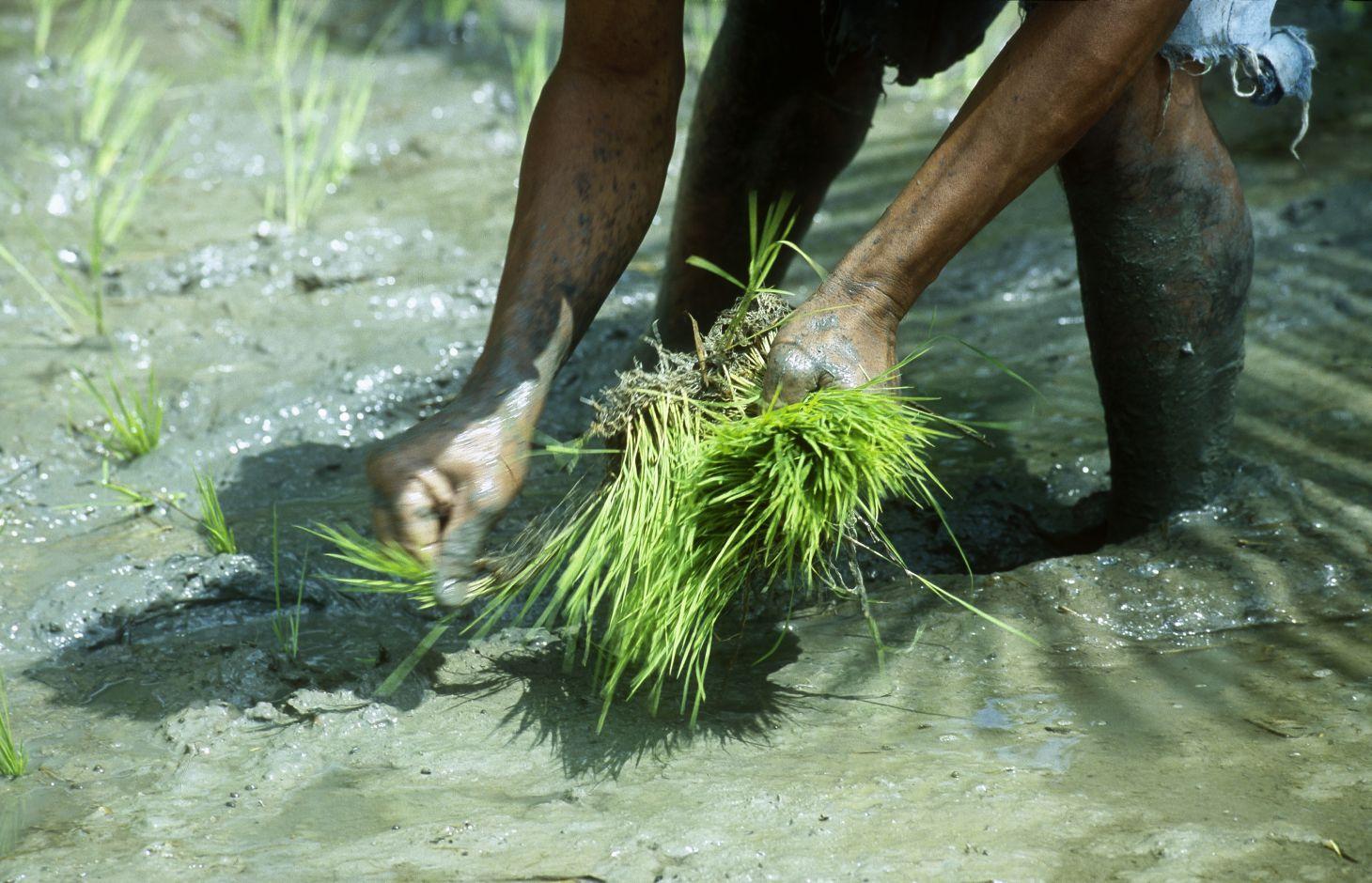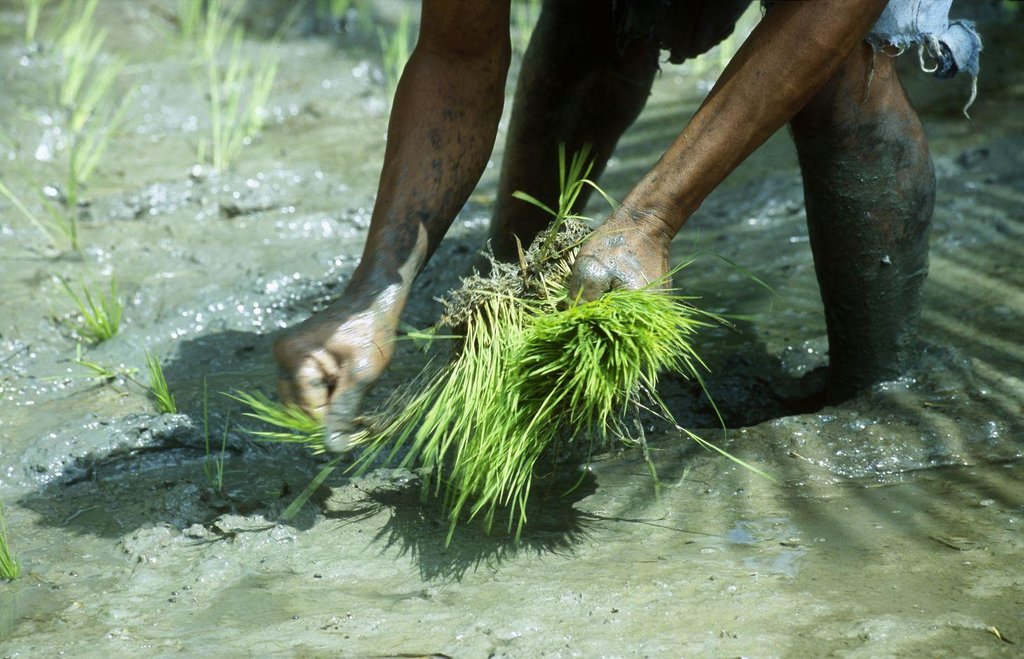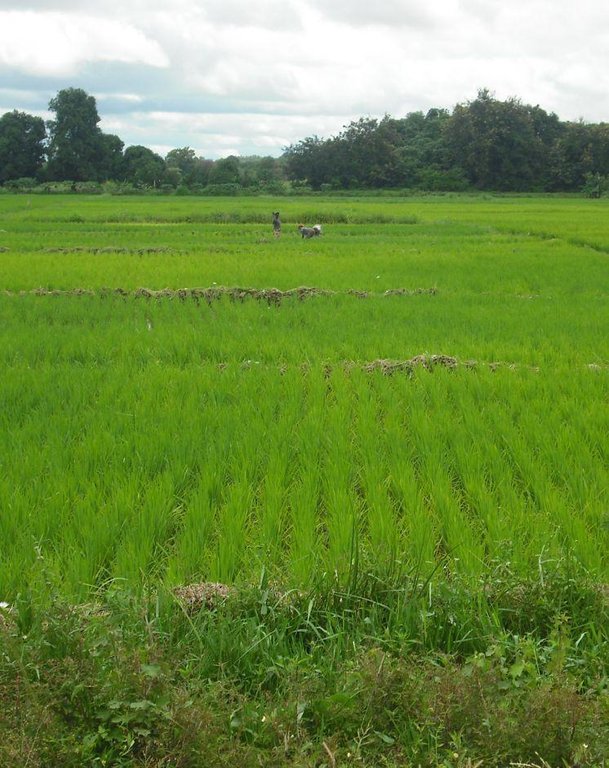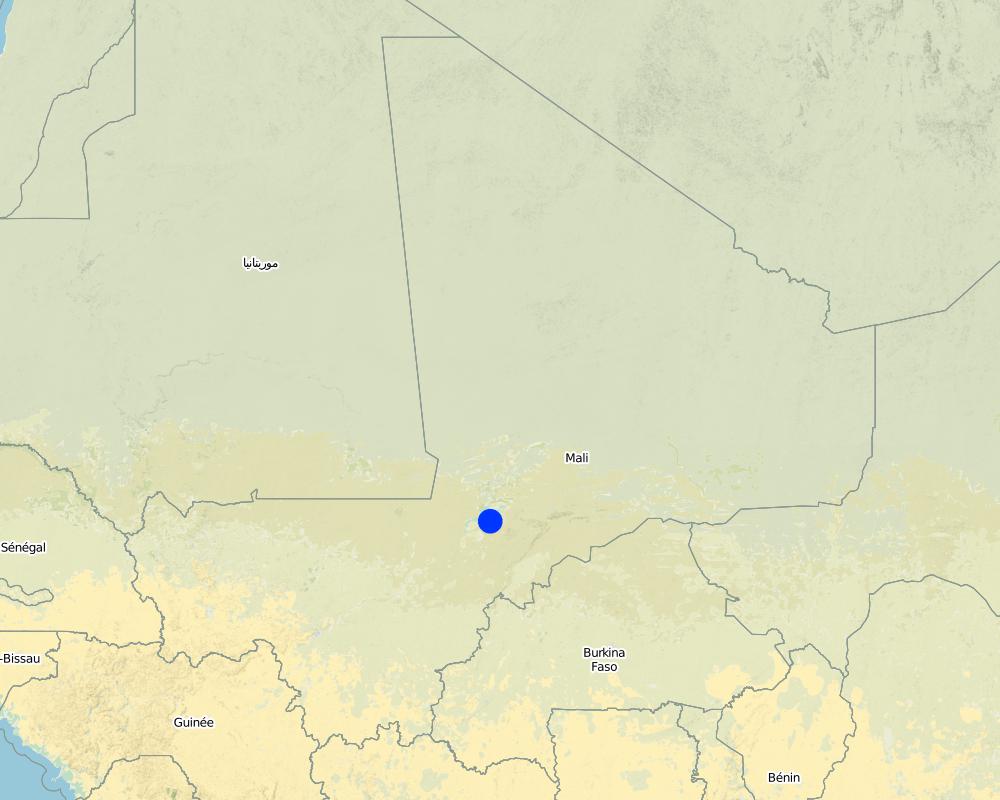System of rice intensification (SRI) [Mali]
- Creation:
- Update:
- Compiler: Dieter Nill
- Editor: –
- Reviewers: Deborah Niggli, Alexandra Gavilano
Système de riziculture intensification (French)
technologies_1654 - Mali
View sections
Expand all Collapse all1. General information
1.2 Contact details of resource persons and institutions involved in the assessment and documentation of the Technology
SLM specialist:
Kouyate Djiguiba
IICEM
SLM specialist:
Traore Minamba
IICEM
Name of project which facilitated the documentation/ evaluation of the Technology (if relevant)
Good Practices in Soil and Water Conservation - A contribution to adaptation and farmers ́ resilience towards climate change in the Sahel (GIZ)Name of the institution(s) which facilitated the documentation/ evaluation of the Technology (if relevant)
Deutsche Gesellschaft für Internationale Zusammenarbeit (GIZ) GmbH (GIZ) - GermanyName of the institution(s) which facilitated the documentation/ evaluation of the Technology (if relevant)
Intgrated Initiative for Economic Growth in Mali (IICEM) - Mali1.3 Conditions regarding the use of data documented through WOCAT
The compiler and key resource person(s) accept the conditions regarding the use of data documented through WOCAT:
Yes
1.4 Declaration on sustainability of the described Technology
Is the Technology described here problematic with regard to land degradation, so that it cannot be declared a sustainable land management technology?
No
2. Description of the SLM Technology
2.1 Short description of the Technology
Definition of the Technology:
The objective of a system of rice intensification (SRI) is increased yields.
2.2 Detailed description of the Technology
Description:
This can be achieved when rice plants are provided with sufficient air and space for their ripening process. Irrigation water supply requirements are lower, which means the approach can be deployed in low-rainfall areas or the rice growing areas can be extended using the same quantity of water (climate change adaptation). The technique requires less seed and fertiliser.
SRI optimises the soil-water-plant relationship. It increases the plants’ potential for production by correcting disadvantageous practices. In practical terms, this involves growing rice on lowlands and plains using fewer seeds (with the rice variety selected according to the water regime) and less fertiliser.
The system of rice intensification proves that rice is not strictly speaking an aquatic crop. Rice growing simply requires a very humid environment. The water level is maintained considerably lower down the rice stalk than it is in traditional rice paddies, where water levels range from 10 to 25 centimetres.
SRI makes it possible to increase yields by around 35% compared to average yields. It has been possible to cut costs given the shorter growing season (90 days). Growers reduce seed use by 8 to 10 kilograms per hectare. Water use drops by around 35%, given that the rice is not constantly submerged and water levels in the paddy are low.
Implementation: Firstly, the growers are sensitised and informed about the principles and benefits of SRI in terms of yields and production costs, and are given the opportunity to sign up for technical training in SRI. IICEM takes charge of monitoring the proper application of the SRI methods over the
growing season. Seedlings are planted out individually to ensure each plant has sufficient space to grow. The rice plants are grown individually in rows, which reduces the number of seeds required and makes weeding easier.
Operation: 1) Selecting the most appropriate rice varieties according to the water regime of the area in question (rainfed rice and lowland rice). SRI rice crops adapt well to flood and recession waters, meaning rising and falling water source levels can be managed. 2) Respecting the irrigation cycles developed with the planner: An irrigation cycle is drawn up with a planner. Training is then provided to the growers managing the irrigation system to ensure they adhere strictly to the cycle. It is important for growers in the same hydraulic area to plant out at the same time so their irrigation supply needs correspond. This ensures that the water requirements of the rice crops are met and reduces pumping costs.
Roles of the actors involved: IICEM delivers training to raise awareness about SRI and provide the relevant skills. Conscious of the need to increase yields, IICEM ensures that this learning is applied in the field. Sometimes local NGOs are tasked with providing training and monitoring. Growers apply the SRI approach and monitor inputs and yields so that operations can be effectively evaluated.
The practice was rolled out in the Mopti, Timbuktu and Gao regions of northern Mali and in Sikasso in the south. Two very small-scale rice fields were installed: one in Deibata in Youwarou Circle and one in Mopti. Farmer organisations supported by IICEM are benefiting from the technique. The practice has been carried out since 2009 by IICEM. It was deployed in Madagascar prior to its introduction in Mali.
2.3 Photos of the Technology
2.5 Country/ region/ locations where the Technology has been applied and which are covered by this assessment
Country:
Mali
Region/ State/ Province:
Mali
Further specification of location:
Mopti, Timbuktu, Gao, Sikasso
Specify the spread of the Technology:
- evenly spread over an area
If precise area is not known, indicate approximate area covered:
- 0.1-1 km2
Comments:
The practice was rolled out in the Mopti, Timbuktu and Gao regions of northern Mali and in Sikasso in the south.
Two very small-scale rice fields were installed: one in Deibata in Youwarou Circle and one in Mopti. Farmer organisations supported by IICEM are benefiting from the technique.
Map
×2.6 Date of implementation
If precise year is not known, indicate approximate date:
- 10-50 years ago
2.7 Introduction of the Technology
Specify how the Technology was introduced:
- through projects/ external interventions
3. Classification of the SLM Technology
3.1 Main purpose(s) of the Technology
- improve production
- create beneficial economic impact
3.2 Current land use type(s) where the Technology is applied

Cropland
- Annual cropping
Annual cropping - Specify crops:
- cereals - rice (wetland)
Number of growing seasons per year:
- 1
Specify:
Longest growing period in days: 120Longest growing period from month to month: August to November
Comments:
Major land use problems (compiler’s opinion): low rice production, high amount of seeds, fertilizer and water required, high production costs
3.4 Water supply
Water supply for the land on which the Technology is applied:
- mixed rainfed-irrigated
3.5 SLM group to which the Technology belongs
- irrigation management (incl. water supply, drainage)
3.6 SLM measures comprising the Technology

management measures
- M2: Change of management/ intensity level
3.7 Main types of land degradation addressed by the Technology

chemical soil deterioration
- Cs: salinization/ alkalinization

water degradation
- Hp: decline of surface water quality
Comments:
Main causes of degradation: soil management (Unadapted landuse methods, reduced or abandoned fallow periods), crop management (annual, perennial, tree/shrub) (Neglect of fallow periods and crop rotation), droughts (due to heat waves), population pressure (rapidly growing population increasing pressure on land), land tenure (insecure access to land and collectively managed communal land), poverty / wealth (very poor population)
Secondary causes of degradation: deforestation / removal of natural vegetation (incl. forest fires) (deforestation through overgrazing and fire wood collection), over-exploitation of vegetation for domestic use (firewood collection), overgrazing (cattle, sheep and goats), change in temperature (Climate change: heat waves), change of seasonal rainfall (more variable onset of rain), Heavy / extreme rainfall (intensity/amounts) (more variable and intensive rains), wind storms / dust storms (frequent storms), floods (due to intensive rain storms), labour availability (some migration of men to nearby cities), education, access to knowledge and support services (high level of illiteracy)
3.8 Prevention, reduction, or restoration of land degradation
Specify the goal of the Technology with regard to land degradation:
- reduce land degradation
4. Technical specifications, implementation activities, inputs, and costs
4.1 Technical drawing of the Technology
Technical specifications (related to technical drawing):
Technical knowledge required for field staff / advisors: moderate
Technical knowledge required for land users: low
Main technical functions: increase in organic matter, improved plant management, improved water management, increases the plants’ potential for production
Change of land use practices / intensity level: system of rice intensification (SRI)
4.2 General information regarding the calculation of inputs and costs
other/ national currency (specify):
CFA Franc
4.3 Establishment activities
| Activity | Timing (season) | |
|---|---|---|
| 1. | Growers are sensitised and informed about the principles and benefits of SRI | |
| 2. | Opportunity to sign up for technical training in SRI | |
| 3. | Selecting rice varieties according to the water regime | |
| 4. | Seedlings are planted out individually to ensure each plant has sufficient space to grow. rice plants are grown individually in rows, which reduces the number of seeds required and makes weeding easier. | |
| 5. | irrigation cycle is drawn up with a planner |
5. Natural and human environment
5.1 Climate
Annual rainfall
- < 250 mm
- 251-500 mm
- 501-750 mm
- 751-1,000 mm
- 1,001-1,500 mm
- 1,501-2,000 mm
- 2,001-3,000 mm
- 3,001-4,000 mm
- > 4,000 mm
Agro-climatic zone
- semi-arid
Thermal climate class: tropics
5.2 Topography
Slopes on average:
- flat (0-2%)
- gentle (3-5%)
- moderate (6-10%)
- rolling (11-15%)
- hilly (16-30%)
- steep (31-60%)
- very steep (>60%)
Landforms:
- plateau/plains
- ridges
- mountain slopes
- hill slopes
- footslopes
- valley floors
Altitudinal zone:
- 0-100 m a.s.l.
- 101-500 m a.s.l.
- 501-1,000 m a.s.l.
- 1,001-1,500 m a.s.l.
- 1,501-2,000 m a.s.l.
- 2,001-2,500 m a.s.l.
- 2,501-3,000 m a.s.l.
- 3,001-4,000 m a.s.l.
- > 4,000 m a.s.l.
5.3 Soils
Soil depth on average:
- very shallow (0-20 cm)
- shallow (21-50 cm)
- moderately deep (51-80 cm)
- deep (81-120 cm)
- very deep (> 120 cm)
Soil texture (topsoil):
- medium (loamy, silty)
- fine/ heavy (clay)
Soil texture (> 20 cm below surface):
- medium (loamy, silty)
- fine/ heavy (clay)
Topsoil organic matter:
- medium (1-3%)
- low (<1%)
5.4 Water availability and quality
Ground water table:
5-50 m
Availability of surface water:
medium
Water quality (untreated):
for agricultural use only (irrigation)
5.5 Biodiversity
Comments and further specifications on biodiversity:
Species diversity: medium, low
5.6 Characteristics of land users applying the Technology
Sedentary or nomadic:
- Sedentary
Market orientation of production system:
- mixed (subsistence/ commercial)
Off-farm income:
- 10-50% of all income
Relative level of wealth:
- poor
- average
Level of mechanization:
- manual work
Gender:
- men
Indicate other relevant characteristics of the land users:
Population density: < 10 persons/km2
Annual population growth: 2% - 3%
50% of the land users are average wealthy.
30% of the land users are poor.
5.7 Average area of land used by land users applying the Technology
- < 0.5 ha
- 0.5-1 ha
- 1-2 ha
- 2-5 ha
- 5-15 ha
- 15-50 ha
- 50-100 ha
- 100-500 ha
- 500-1,000 ha
- 1,000-10,000 ha
- > 10,000 ha
Is this considered small-, medium- or large-scale (referring to local context)?
- small-scale
5.8 Land ownership, land use rights, and water use rights
Land ownership:
- state
Land use rights:
- communal (organized)
Water use rights:
- communal (organized)
Comments:
The irrigated land is allocated by the chief
5.9 Access to services and infrastructure
health:
- poor
- moderate
- good
education:
- poor
- moderate
- good
technical assistance:
- poor
- moderate
- good
employment (e.g. off-farm):
- poor
- moderate
- good
markets:
- poor
- moderate
- good
energy:
- poor
- moderate
- good
roads and transport:
- poor
- moderate
- good
drinking water and sanitation:
- poor
- moderate
- good
financial services:
- poor
- moderate
- good
6. Impacts and concluding statements
6.1 On-site impacts the Technology has shown
Socio-economic impacts
Production
crop production
risk of production failure
Water availability and quality
demand for irrigation water
Income and costs
expenses on agricultural inputs
Comments/ specify:
reduced demand for seeds and fertilizer, shorter growing season
farm income
Socio-cultural impacts
food security/ self-sufficiency
health situation
cultural opportunities
recreational opportunities
community institutions
national institutions
SLM/ land degradation knowledge
conflict mitigation
situation of socially and economically disadvantaged groups
Contribution to human well-being
Comments/ specify:
SRI makes it possible to increase yields by around 35% compared to average yields. It has been possible to cut costs given the shorter growing season (90 days).
Ecological impacts
Water cycle/ runoff
water quantity
Biodiversity: vegetation, animals
biomass/ above ground C
6.3 Exposure and sensitivity of the Technology to gradual climate change and climate-related extremes/ disasters (as perceived by land users)
Gradual climate change
Gradual climate change
| Season | increase or decrease | How does the Technology cope with it? | |
|---|---|---|---|
| annual temperature | increase | well |
Climate-related extremes (disasters)
Meteorological disasters
| How does the Technology cope with it? | |
|---|---|
| local rainstorm | not well |
| local windstorm | well |
Climatological disasters
| How does the Technology cope with it? | |
|---|---|
| drought | not well |
Hydrological disasters
| How does the Technology cope with it? | |
|---|---|
| general (river) flood | not well |
Other climate-related consequences
Other climate-related consequences
| How does the Technology cope with it? | |
|---|---|
| reduced growing period | not well |
6.4 Cost-benefit analysis
How do the benefits compare with the establishment costs (from land users’ perspective)?
Short-term returns:
positive
Long-term returns:
very positive
How do the benefits compare with the maintenance/ recurrent costs (from land users' perspective)?
Short-term returns:
very positive
Long-term returns:
very positive
6.5 Adoption of the Technology
Comments:
There is a moderate trend towards spontaneous adoption of the Technology
Comments on adoption trend: The practice has been carried out since 2009 by IICEM. It was deployed in Madagascar prior to its introduction in Mali. Growers who have been trained in SRI continue using the technique as they value its effects;
namely, achieving higher productivity without incurring excessive costs related to inputs, pump unit consumables, etc.
6.7 Strengths/ advantages/ opportunities of the Technology
| Strengths/ advantages/ opportunities in the land user’s view |
|---|
| The rice plants are grown individually in rows, which reduces the number of seeds required and makes weeding easier. |
| Strengths/ advantages/ opportunities in the compiler’s or other key resource person’s view |
|---|
| SRI makes it possible to increase yields by around 35% compared to average yields. |
| It has been possible to cut costs given the shorter growing season (90 days). |
| Growers reduce seed use by 8 to 10 kilograms per hectare. |
| Water use drops by around 35%, given that the rice is not constantly submerged and water levels in the paddy are low. |
| Growers who have been trained in SRI continue using the technique as they value its effects; namely, achieving higher productivity without incurring excessive costs related to inputs, pump unit consumables, etc. |
6.8 Weaknesses/ disadvantages/ risks of the Technology and ways of overcoming them
| Weaknesses/ disadvantages/ risks in the compiler’s or other key resource person’s view | How can they be overcome? |
|---|---|
|
SRI growers are strongly advised to use organic fertilisers to supplement soil nutrient levels. Organic fertiliser is not, however, available. |
7. References and links
7.1 Methods/ sources of information
- field visits, field surveys
- interviews with land users
When were the data compiled (in the field)?
01/07/2012
7.2 References to available publications
Title, author, year, ISBN:
Manual of Good Practices in Small Scale Irrigation in the Sahel. Experiences from Mali. Published by GIZ in 2014.
Available from where? Costs?
http://star-www.giz.de/starweb/giz/pub/servlet.starweb
Title, author, year, ISBN:
Farmer Returns to Rice, IICEM
Title, author, year, ISBN:
IICEM leaflet on SRI
Links and modules
Expand all Collapse allLinks
No links
Modules
No modules





